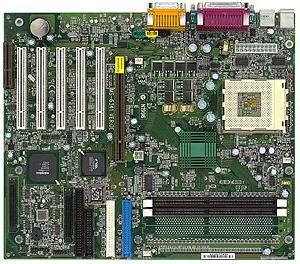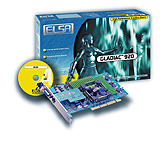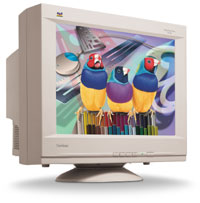Buyer's Guide: High-End Systems - June 2001
by Mike Andrawes on June 11, 2001 12:00 PM EST- Posted in
- Guides
High-end Gaming System
The purpose of this system is simple - maximum frame rates at all costs. Of course, we already have a “cost is no object” dream system, so "all costs" isn't taken quite so literally. We've decided to shoot for a price in the $3000 range on the high-end gaming system. That price is without floppy, keyboard, mouse, or software. Even though it's not in the price, we will recommend an OS configuration.
 Processor
- AMD Athlon 1.33 GHz - $200
Processor
- AMD Athlon 1.33 GHz - $200
Clock for clock, the Athlon may be a bit slower than the Pentium III at
games, but with a 1.33GHz Athlon, you're certainly faster than the similarly
priced Penitum III 1GHz. Both of these processors are the fastest readily available
versions of the processors. The Pentium 4 does offer higher gaming performance,
but with the higher cost of the processor, memory, and motherboard it's just
not worth it.
For these reasons, we've chosen an Athlon 1.33 GHz, the fastest currently available. Even though it's AMD's top of the line CPU, it's still quite affordable at $200 thanks to the recent price wars between AMD and Intel.
The new AXIA core stepping on these processors allows them to overclock fairly easily to 1.4 GHz and sometimes up to 1.5 GHz.
For more information on all Athlon processors, read our AMD Athlon "Thunderbird" 1.33GHz/1.30GHz Review and our Thunderbird / Duron Overclocking Guide.
Motherboard - MSI K7 Master- $175
Motherboards based on AMD's 760 Chipset
are finally available in the "do it yourself" market, allowing us
to finally select it for the buyer's guide. Eventually, production of the standard
760 will slowdown significantly as AMD is not really interested in becoming
a major chipset supplier. For now, however, the 760 is still available and is
the best overall DDR SDRAM chipset available, albeit at a slight price premium
over competing VIA and ALi solutions.

While we haven't reviewed too many AMD 760 based boards, we have had lots of experience with quite a few AMD 760 boards, in particular the ASUS A7M266, Gigabyte GA-7DX, and Microstar K7 Master. The ASUS and Gigabyte are both good boards in their own right, but both lack multiplier controls, which will severely hinder any overclocking attempts. If you're not overclocking, either board will serve you well and offer great performance and stability. The ASUS does offers a more extensive range of FSB speeds and overclocking options than the Gigabyte if you're going to forgo the multiplier overclocking route anyway. The K7 Master, on the other hand, offers similar levels of performance and stability, but adds jumperless multiplier controls.
If you want SCSI support, the K7 Master-S is identical with the addition of onboard Adaptec Ultra 160 SCSI.
For more information, see our AMD 760 Chipset Review and April 2001 Socket-A Chipset Comparison.
Memory - 256MB Corsair/Crucial/Mushkin CAS2.5 PC2100 DDR SDRAM - $75
Even though memory is relatively cheap these days, 256MB is more than enough.
We could have dropped down to 128MB, but the savings didn't justify the performance
loss, although bumping up to 512MB may be worth it, depending what you use your
computer for, but it generally won't make a difference in games.
As for the exact brand of memory, we recommend Corsair, Crucial, or Mushkin modules. We use them in our test systems and have had absolutely no problems with them.
Video card - Elsa Gladiac 920 GeForce3 - $375
 In
the past, we've had a tough time making the call between the ATI
Radeon and the NVIDIA GeForce 2 GTS, but
the call always went to NVIDIA thanks to better drivers. This time around, the
GeForce3 is the clear choice since it's the
first fully DirectX 8 compliant part on the market, offerring a fully programmable
T&L engine and vertex shaders, which makes it the biggest leap forward in
3D graphics in quite some time.
In
the past, we've had a tough time making the call between the ATI
Radeon and the NVIDIA GeForce 2 GTS, but
the call always went to NVIDIA thanks to better drivers. This time around, the
GeForce3 is the clear choice since it's the
first fully DirectX 8 compliant part on the market, offerring a fully programmable
T&L engine and vertex shaders, which makes it the biggest leap forward in
3D graphics in quite some time.
Although 2D image quality has been a complaint of many NVIDIA-based cards, this is really a function of the board manufacturer. With that in mind, we've gone with Elsa's GeForce3 solution, the Gladiac 920, since they tend to offer better 2D output quality than some other manufacturers. A BNC cable connection to your monitor may also help the situation if you're concerned about 2D image quality.
If your gaming system is getting a bit pricey, drop the GeForce3 in favor of a GeForce2 Pro or Radeon DDR to cut the cost of the video card almost in half. You can always upgrade to a GeForce3 later.
For more information, read our GeForce3 Unveiled, GeForce3 Performance Results, and GeForce3 Investigated articles.
 Monitor
- Viewsonic P220F - $775
Monitor
- Viewsonic P220F - $775
With the price of 21-22" monitors dropping so much recently, it's finally
time to bump up to a good 21-22" monitor. The toughest part of this decision
may be between an aperture grill or traditional CRT. Aperture grills are used
in Sony Trinitron and Mitsubishi DiamondTron tubes, with the latest versions
of these being perfectly flat. The disadvantage of aperture grills are the fine
lines produced by the damper wires required to hold the grill in place. Some
people find the flatness and brightness of the design to be worth the sight
of the damper wires, while others can't stand them. As such, this is a very
personal choice.
Nevertheless, we're going to make a recommendation here anyway. The Viewsonic P220F is a reasonably priced 22" monitor using a DiamondTron NF tube. It supports resolutions up to 1600x1200 and has a 0.25 - 0.27 variable grill pitch.










0 Comments
View All Comments